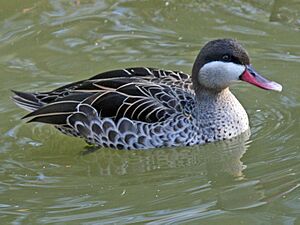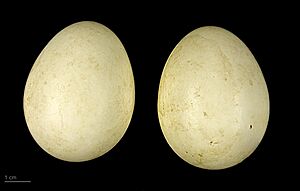Red-billed teal facts for kids
Quick facts for kids Red-billed teal |
|
|---|---|
 |
|
| Male | |
| Conservation status | |
| Scientific classification | |
| Genus: |
Anas
|
| Species: |
erythrorhyncha
|
The Red-billed Teal or Red-billed Duck (Anas erythrorhyncha) is a common type of duck found in southern and eastern Africa. These ducks are known as dabbling ducks because they feed by tipping their bodies forward to reach food just under the water's surface, instead of diving completely.
Unlike some birds, Red-billed Teals do not migrate long distances every year. However, they can fly far to find good places to live. They are very social birds outside of the breeding season, often forming large flocks with many other ducks.
Contents
About the Red-billed Teal
The Red-billed Teal is a medium-sized duck, usually about 43 to 48 centimeters (17 to 19 inches) long. It has a dark cap on its head and neck, which stands out against its lighter face. Its most noticeable feature is its bright red bill.
The rest of its body plumage (feathers) is a dull dark brown with white patterns, like scales. When it flies, you can see that its secondary flight feathers (feathers on the wing) are a light yellowish-brown with a black stripe across them. Male and female Red-billed Teals look very similar. Young ducks are usually not as brightly colored as adults.
Sounds and Calls
This duck is generally quiet. However, when a male Red-billed Teal is trying to attract a mate, it makes a soft "whzzt" call. The female duck has a gentle quack, similar to a mallard duck.
Where They Live and What They Eat
Red-billed Teals prefer freshwater habitats in open areas. They are omnivores, meaning they eat both plants and small animals. They find their food by dabbling in the water for plants. They also look for food on land, especially in the evening or at night.
When it's time to lay eggs, the female Red-billed Teal builds her nest on the ground. She chooses a spot with thick plants close to water to keep her eggs safe.
Conservation Efforts
The Red-billed Teal is one of the species covered by the Agreement on the Conservation of African-Eurasian Migratory Waterbirds (AEWA). This agreement helps protect waterbirds that travel between Africa and Eurasia, even though the Red-billed Teal itself doesn't migrate far.
Images for kids





